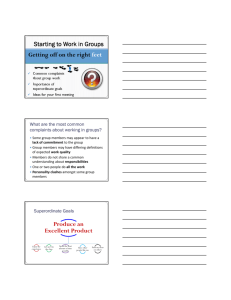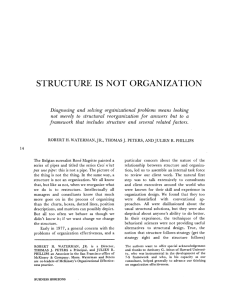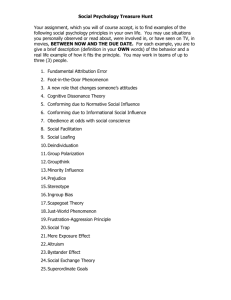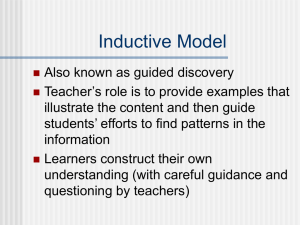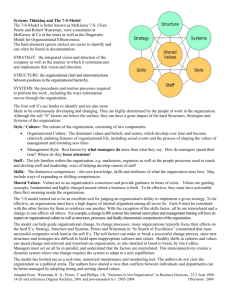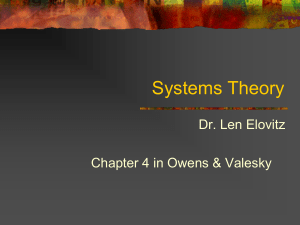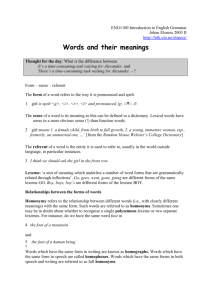ORGANIZATION MANAGEMENT
advertisement
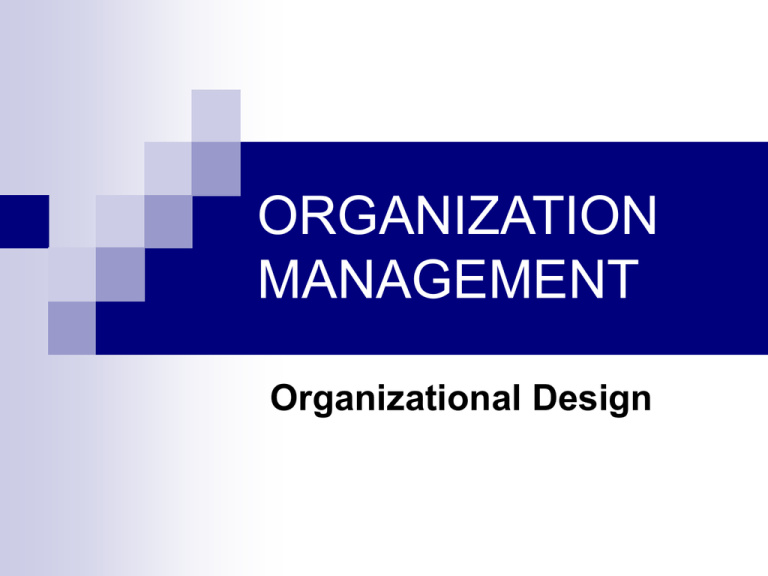
ORGANIZATION MANAGEMENT Organizational Design McKinsey 7-S Model Strategy Structure Systems Style Staff Skills Superordinate goals McKinsey 7-S Model Strategy The Hard S’s Structure The hard elements are factual and easy to identify. They can be Systems found in strategy statements, Style corporate plans, organization charts, and other documentation Staff Skills Superordinate goals McKinsey 7-S Model Strategy Structure Systems Style Staff Skills Superordinate goals The Soft S’s The soft elements are difficult to describe since they are continuously developing and changing. They are highly determined by the people at work in the organization. 7-S Model – The Hard S’s Strategy Actions a company plans in response to or in anticipation of changes in its external environment Structure Strategy Structure Systems Style Staff Skills Superordinate goals Basis for specialization and coordination, influenced primarily by strategy and by organization size and diversity Systems Formal and informal procedures that support the strategy and structure (Systems are more powerful than they are given credit) Organizational Structure Organization Chart formal reporting relationships levels in hierarchy spans of control departmentalization Systems to facilitate: coordination communication integration Strategy Structure Systems Style Staff Skills Superordinate goals Structural Designs Functional Structure Strategy Structure Systems Style Staff Skills Superordinate goals Can adapt functional structure with horizontal linkages Divisional Structure Geographical Structure Matrix Structure Horizontal Structure / Product Line Structure Hybrid Structure CEO Vice President Fianance Chief Accountant Budget Analyst Vice President Manufacturing Plant Maintenance Superintendent Superintendent Director Human Resources Training Specialist Benefits Administrator Other Organizational Forms Joint Ventures Licensing agreements Strategic Alliances Consortia Virtual organizations Global (transnational) Work Teams Strategy Structure Systems Style Staff Skills Superordinate goals Virtual Teams Virtual Teams are characterized by: Strategy Structure Systems Style Staff Skills Superordinate goals Distributed locations of team members Use of information technology to accomplish tasks Effective when: Communication & collaboration skills are high. Trust among team members is high Organizations are increasing their use of virtual teams Potential for improvement in virtual team management is huge Information Linkages Vertical Information Linkages Hierarchy Rules and plans (i.e. budget) Horizontal Information Linkages Information Liaison systems role Task force Integrator role (i.e. Project manager) Cross-functional teams Strategy Structure Systems Style Staff Skills Superordinate goals Ladder of Mechanisms for Horizontal Linkage and Coordination Teams Amount of Horizontal Coordination Required H IGH Full-time Integrators Task Forces Direct Contact LOW Information Systems LOW HIGH Cost of Coordination in Time and Human Resources Systems – various elements Strategy Structure Systems Style Staff Skills Superordinate goals Communications practice and system Management reporting system Approval process Planning/budgeting system Rewards system including appraisal “Rules” From Tasks to Structure Strategy Structure Systems Style Staff Skills Superordinate goals Tasks define jobs Jobs define skills required Skills (and other considerations) define staff Over time skills change as staff gains knowledge and experience, and as technology and corporate infrastructure mature Collection of jobs basis for structure Job design considerations Do they have the necessary skills and knowledge to fulfill proposed / expanded job requirements? What are the needs of the incumbent or the rest of your workforce in general? Monetary Growth Socialization Strategy Structure Systems Style Staff Skills Superordinate goals 7-S Model – The Soft S’s - 1 Style / Culture Strategy Structure Systems Style Staff Skills Superordinate goals The culture of the organization, consisting of Organizational culture: the dominant values, beliefs and norms which develop over time and become relatively enduring features of organization life Management style: what managers do rather than what they say (where they spend their time and attention, what they allow, what they reward, etc) Staff Skills Shared values / Superordinate goals 7-S Model – The Soft S’s - 2 Style / Culture Staff The people/human resource management – ways of shaping basic management values, processes used to develop managers, ways of introducing new employees and managing careers, socialization processes Skills Strategy Structure Systems Style Staff Skills Superordinate goals Distinctive competencies – what the company does best, ways of developing or shifting competencies Shared values / Superordinate goals Guiding concepts, fundamental ideas around which a business is built – simple, usually stated at abstract level, have great meaning inside the organization, although outsiders may not see or understand them Organizational Culture Culture is to organizations what personality is to individuals All companies have cultures Strategy Structure Systems Style Staff Skills Superordinate goals Culture by default Culture by design – thoughtful choices based on values and core beliefs How does a company consciously create its culture? From Gray & Larson “Project Management: The Managerial Process” Types of Organizational Cultures Control cultures – Drive for predictability and order Collaboration cultures – Strategy Structure Systems Style Staff Skills Superordinate goals Pursue close relationship with customers Competence cultures – Pursue excellence and innovation Cultivation cultures – Pursue life enrichment for customers and employees Organizational Culture Observable Evidence: Strategy Structure Systems Style Staff Skills Superordinate goals Symbols Ceremonies Stories Behaviors Language Dress Underlying Roots: Values, Assumptions, Beliefs, Attitudes, Feelings Culture in practice Conflict management Strategy Structure Systems Style Staff Skills Superordinate goals Relationship or interpersonal conflict Task / process conflict Functional vs. dysfunctional conflict Factors: goal incompatibility, limited resources, differences Power – the capacity to influence behavior Positional power: rewards/consequences, control of resources, information and decision control Personal power: expert, referent (based on identification and admiration) Politics – the use of power to influence decisions Management vs. Leadership Planning & budgeting vs. Setting the direction Organizing & staffing vs. Aligning people Controlling & problem solving vs. Motivating people Management is about coping with complexity Leadership is about coping with change Management vs. Leadership Some managers (but not all) are leaders Some leaders (but not all) are good managers A manager gets work done through the efforts of other people Includes planning, organizing, motivating, and controlling A leader creates and realizes a vision Communicates that vision and moves the organization toward that vision Strategy Structure Systems Style Staff Skills Superordinate goals McKinsey 7-S Model Strategy Structure Systems Style Staff Skills Superordinate goals Effective organizations achieve a harmony between these seven elements; if one element changes, then this will affect all the others McKinsey 7-S Model Strategy Structure Systems Style Staff Skills Superordinate goals The 7-S Model can be a valuable tool to initiate change processes and to give them direction; i.e. determine current state and ideal state of each element, and develop action plans to close the gaps McKinsey 7-S Model Strategy Structure Systems Style Staff Skills Superordinate goals In change processes, many organizations focus their efforts on the hard S’s; however, the soft factors can make or break a successful change process. All factors must be accounted for. McKinsey 7-S Model Strategy Structure Systems Style Staff Skills Superordinate goals Interrelated Equilibrium Foundation of corporate culture Levers available to management Executing Change – Seven Key Considerations Strategic Intent Substance Scale Scope/Breadth Speed Sequence Style Style Scope Substance Strategic Intent Speed Scale Sequence Strategic Intent Precise Large Organization-wide Fast Sequence Hard – Soft Hard S’s Speed Slow Speed Scope/Breadth Isolated Soft – Hard Style Top Down Substance Scope Strategic Intent Scale Small Broad Substance Soft S’s Style Bottom Up Scale Sequence Assignment Read BA 550 class packet: Turning Great Strategy into Great Performance Governance and Strategy Implementation Case brief – Americhem Last names beginning with A – M Complete proposal on term project
